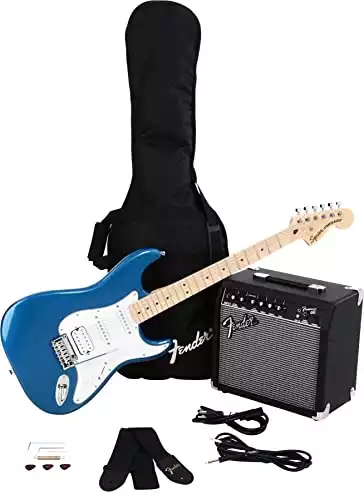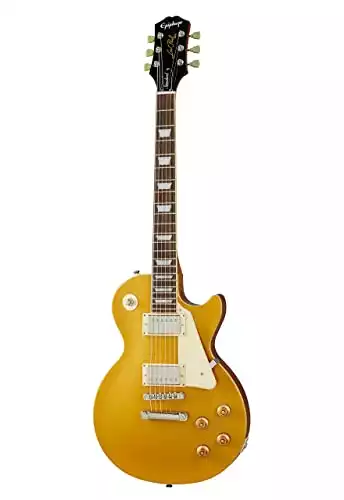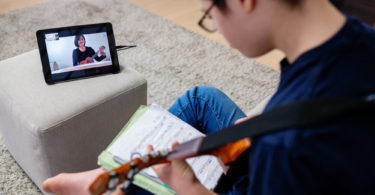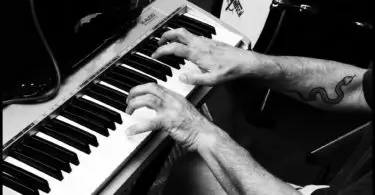One of the first questions that needs to be answered when someone takes the leap and starts to learn how to play the guitar is “should I get an acoustic or an electric?”
That is a question only you can answer. That said, many beginner players choose an electric guitar.
What are the best electric guitars for beginners?
Before we dive right into our list, we should make a few points.
The biggest thing when looking for a good electric guitar is not to let yourself be influenced by price. To be sure, there was a time when ‘inexpensive’ really meant nothing more than ‘cheap’ – cheap construction, cheap components, cheap quality, and cheap sound. Besides, guitars that cost more have to be better, right?
That’s not really the case these days. Guitar manufacturers have improved their processes over the years. You can now find guitars priced right in the budget/beginner/starter range that rival those that can cost several times more. That’s great news for someone starting out who is looking for a quality instrument.
So…keeping that in mind…let’s take a look at our list of the best electric guitars for beginners.
Best Overall: Squier Classic Vibe ‘50s Stratocaster
There are very few guitars that are iconic enough to go head-to-head with the iconic Fender Stratocaster. However, even with Fender’s own ‘budget’ line, you’ll often find street prices over in the sub-$1000 range.
The Squier Classic Vibe ‘50’s Stratocaster takes everything that has endeared the Stratocaster to generations of guitarists and delivers it in an extremely affordable package which is sure to impress. It rings true to the vintage Strat traditions, with three single-coil pickups voiced just right for rock, country, or blues.
In our eyes, the Best Overall pick for any category strikes that near-perfect balance between features, quality, and affordability, and this model certainly meets all of those criteria. Just because it doesn’t say ‘Fender’ on the headstock doesn’t mean that it isn’t a worthy contender!
Many of Squier’s upper-end models such as the Classic Vibe Stratocaster play and sound great right off the rack. If you take the time to get a good setup done, though, you may find little difference between it and other ‘real’ Stratocasters that are up to four or five times the price.
Best Combo Pack – Fender Affinity Series Stratocaster HSS Pack
For many beginners, buying a combo pack is absolutely the right choice. With these kits, you not only get a fairly decent guitar, but you also get many (if not all) of the extra accessories that you need to complete your rig – even a small practice amplifier. And, you can get it all for roughly the same price as you’d pay for some beginner guitars alone.
We know it may seem like we are on a Stratocaster kick here, but there’s no doubting the appeal that they have. The Fender Affinity Series Stratocaster HSS Pack is our pick for the Best Combo Pack for beginners because, simply, we have not come across a package that has this much bang for the buck.
To clear up any confusion, yes – Squier is a brand that is manufactured and distributed by Fender.
Fender took the Squier Affinity Series Stratocaster and paired it up with a Frontman 15G amplifier, a guitar strap, an instrument cable, a gig bag, and a set of extra guitar picks just for good measure.
On top of that, it also comes with a free three-month subscription to Fender Play – Fender’s online guitar lesson course.
Add it all up and this package is a close-to-perfect springboard into the world of playing the electric guitar.
Best Budget: Epiphone Les Paul Standard ‘50s Electric Guitar
Ranking right up with the Stratocaster for the title of the most iconic electric guitar is the Gibson Les Paul. Everyone from Jimmy Page to Joe Walsh, Ace Frehley, and Slash has played them, and for good reason – they are solid guitars with exceptional sound and playability.
Unfortunately, a ‘real’ Gibson Les Paul Standard can also come with an exceptional price tag.
Making our choice for the Best Budget guitar for beginners is the Epiphone Les Paul Standard ‘50’s model. Just as with Squier being the ‘budget’ sub-brand of Fender, Epiphone holds that same distinction with Gibson.
But, as we noted earlier, you shouldn’t be afraid of many so-called ‘budget’ models in the current market. The Epi Les Paul Standard is truly a great guitar that has most of the same features as it’s Gibson cousin (two humbucking pickups, two volume/two tone controls, set-neck construction), all at a price point that is sure to please.
To be fair, the Epi Les Paul does approach the higher end of what may be considered the budget range of guitars. In this case, however, we have little doubt that what you get is worth every penny.
Best Used – PRS SE Custom 24
PRS has evolved as a brand over the last several decades to become a top contender in the guitar market. Their new models do carry an air or top-tier quality and an essence of class that you may not find with some of the other nameplates on the market.
Originally offered in 2001 as a beginner/budget model based on the PRS model used by Carlos Santana, the PRS SE series has come to encompass several different models, with the Custom 24 (preceded by the Custom 22; the number relates to the number of frets) becoming a coveted model for many guitarists looking for the PRS quality without the cost that comes with buying new.
The PRS SE Custom 24 combines several elements from both the Stratocaster (double cutaway body) and the Les Paul (dual humbuckers; set neck construction). This design is a perfect gateway into the world of high end guitars, and finding one on the used market can be a great buy.
From a cost standpoint, a little research on the market with online retailers can land you one in the sub-$500 range. It’s a great price for a great guitar, and it is certainly our selection for the Best Used electric guitar for beginners.
Tips and advice for beginner guitar players
Getting a new (or new-to-you) guitar that you really like is only the first step you have to take when learning to play the guitar. You should consider several things that will help take your skill and knowledge to the next level.
But there lies the challenge, right? When you’re a beginner it’s sometimes tough to know what to do, when to do it, and how to do it.
Now it’s time to take a few minutes and do a quick review of some of the most important things you should be aware of when starting your quest of learning how to play the guitar…
How to use an amp
Electric guitars were made for one distinct purpose – being able to amplify them! By their nature, you won’t be able to hear yourself very well when playing an electric unless you do have them run into some sort of amplifier. On your first time out, though, you may find yourself wondering what the right way is to use a good guitar amp. Nothing to fear here…it’s actually pretty simple!
All you need is an electric guitar, a good quality instrument cable, and a decent guitar amp. First you should make sure that the power to the amp is off. Plug one end of the cable into the output jack on the guitar, and then the other end into the input jack of the amp.
We’d highly recommend that you do it in this order, as if the power to the amp is inadvertently switched on, and the instrument cable is hooked up to the amp first, you will get some pretty loud buzzing and crackling when you attempt to plug into the guitar.
From there, simply adjust the controls on the amp to get the sound and volume that you want. Depending on the amp, you may be able to go from pristine clean tones to some pretty intense hard distortion.
Common beginner mistakes
Learning to play the electric guitar is a process, and along the way a beginner is bound to make some mistakes. These mistakes can range from technique-related items to things having directly to do with the guitar itself.
A partial list of things to watch out for can include:
- Buying a guitar that doesn’t fit your body
- Not having a guitar set up to play as well as possible
- Trying to learn too fast (taking on too much at a time)
- Not practicing enough
- Learning improper playing techniques
- Not learning how to tune your guitar properly
- Avoiding learning music theory topics
- Not pushing yourself to keep learning – you can never know everything
What if you are left-handed?
Being a left-handed guitarist really isn’t a big deal – not at all. In fact, some of the most iconic and influential musicians that have ever played are lefties (Paul McCartney and Jimi Hendrix are great examples).
The only real challenge you may find with being a left-handed player is the availability of guitars to use. Instruments which are designed for left-hand use aren’t uncommon, but at the same time they certainly aren’t as plentiful as right-handed guitars are.
But don’t let that stop you! Hendrix himself simply took a right-handed guitar and flipped it over!
What if you have small hands?
If you are younger in age or just happen to have smaller body dimensions, you may find that a standard sized guitar presents some challenges with paying them comfortably. A few examples are the overall size of your electric guitar may be too big to hold in the right manner and the fret spacing on the neck being to spread apart down by the nut to finger chords in the right manner.
Fortunately, there is an entire market for guitars that are manufactured with smaller scale. These instruments can solve all of the problems related to smaller hands, and they typically can be guitars with the same level of quality as their bigger siblings.
They are a very common choice for children that are just starting out, and they are the perfect options for them to work on until they can grow into a full-size guitar. For some older players, they simply are their guitar of choice.
What to consider for metal fans?
It’s easy to think that ‘a guitar is just a guitar,’ and that any model should work for any style of music. That being said, some genres – such as metal – can lend themselves to distinct guitar designs and characteristics that make it easier to play and get the sounds you’re looking for.
A lot of metal players tend to want to learn to solo in a very fast manner and style (sometimes referred to as ‘shredding’). Guitars that are designed with a flatter neck radius can help a lot in this regard. Different string spacings and lower string action can also help things out a great deal.
When it comes to the molten and saturated tone that comes with extreme metal distortion, the guitar itself can help out quite a bit there as well. In particular, having the right pickups can make a world of difference. There are numerous options on the market that are specifically designed for this, with higher output and EQ profiles that are targeted for metal and higher distortion uses.
What is the best way to learn?
In this day and age, we are fortunate to be able to have many options for learning to play the guitar that were not available many years ago. The evolution of the internet has opened up a wide range of tools and resources that any guitar player can take advantage of. YouTube videos are a popular option for learning without any cost, and there is no shortage of free online articles that cover just about any guitar-related topic you can think of.
Paid online courses can take your skills to the next level. They are plentiful, and relatively inexpensive. Some of the more popular ones are:
- Fender Play
- JamPlay
- Yousician
- TrueFire
Then there is always the ‘old school’ approach of purchasing some print books and using them as resources to learn music theory and playing techniques.
All of that is great if you’re looking to be self-taught and also save yourself some money in the long run. At the same time, taking private lessons from a qualified guitar teacher may be the path that some should take. Not only can you have someone guide you along the way, they can also instill a sense of accountability to make sure you are practicing as you should.
What are some good songs for a beginner to learn?
Regardless of the type of music that you prefer to play, there are a good number of songs that are easy to play which makes them great choices for any beginner to learn. Songs where there is a lot of strumming are always good picks; ones that are more challenging can be a bit frustrating to play well when your skill sets aren’t developed all that well.
Here are a few examples:
- Brown Eyed Girl – Van Morrison
- Take Me Home, Country Roads – John Denver
- Sweet Home Alabama – Lynyrd Skynyrd
- Tennessee Whiskey – Chris Stapleton
- Smoke On The Water – Deep Purple
- Take Me Home, Country Roads – John Denver
What accessories should a beginner guitar player have?
While having an electric guitar and an amp can be considered a ‘complete’ rig, there are a few accessories that every guitar player should have handy.
First and foremost is a good quality guitar tuner. Granted, you can tune a guitar by ear, but that’s a process that may be hard for most beginners. A tuner will let you get tuned up quickly and accurately, many times much more so than doing it manually.
Next are some of the things that are simply a must-have: extra guitar strings, an extra instrument cable, a cleaning cloth, and extra guitar picks should be in every player’s gig bag or guitar case.
Do you really need to have all of these on hand? No, but take it from us – not having them when you need them can really cramp your style if, for example, you break a string right in the middle of your practicing session or you lose your pick (trust us – it happens!)
Intro to guitar maintenance
One of the most important things that you can do for your electric guitar is to simply take care of it. Regardless of how much you paid for it, you really should consider it an investment. Keeping a basic maintenance regimen will ensure that your guitar will play and look its best for many years to come.
And it’s really not that hard to do. Here are few simple things to do to keep your guitar in tip-top shape:
Keep it clean
A soft microfiber cleaning cloth is very inexpensive, and using one to wipe your guitar down after each time you play can be your first defense with letting dirt and grime build up. Give the entire guitar a good wiping; doing the neck will get finger sweat and grime off. It also will help to do a more thorough cleaning and polishing every now and then as well.
Change strings often
Strings get old over time as you play your guitar. They really do have a lifespan, and the longer you go without changing them you may start to have performance problems. They won’t stay in tune, and the tone just won’t be as good as it was when they were first put on
Watch for changes in playability
Since guitars are made almost entirely from wood, they are susceptible to changes in the environment. It’s not uncommon at all for the action to change during the winter when humidity tends to be low. Sometimes various adjustments will need to be made (such as the truss rod or string height) to accommodate for the variances.
These adjustments aren’t necessarily hard to do, but they can be daunting for a beginner. While we recommend learning how to maintain your guitar yourself, a good option would be to take it to a seasoned professional for a good setup.
Conclusion
Picking the best electric guitar for beginners is, truthfully, a somewhat subjective task. Each player has different wants, needs, and physical attributes, and somewhere on the market is a model that will best meet their needs.
Whether you are looking for a great all-in-one solution such as the Fender Affinity Series Stratocaster HSS Combo Pack (a great approach for many beginners) or just looking for what may be the Best Overall (the Squier Classic Vibe ‘50s Stratocaster), our recommendation is to do a little research. Taking the time upfront to find the best beginner’s electric guitar that fits your needs will definitely help to keep you inspired while you tackle the challenges of learning how to play.
Aside from selecting the best model for your tastes, it’s also important to consider many of the other parts that come with learning to play. Things such as maintaining your guitar, knowing which accessories are the right ones to have, and being aware of what beginner mistakes are critical to your success.
And here’s the prize towards the end of the journey: at some point you will start playing and things will just feel right and you’ll understand what you’re doing. That’s when you’ll realize that you simply aren’t a beginner anymore!
Sources
- Mathis, J. (2021, February 27) Personal Interview
- Top Accessories Every Guitar Player Should Have (2020, July). Retrieved from https://guitarplayers.online/guitar-accessories/
- The 13 Most Iconic Left-Handed Guitarists Of All Time (2020, August). Retrieved from https://mixdownmag.com.au/features/columns/the-13-most-iconic-left-handed-guitarists-of-all-time/
- Playing Guitar with Small Hands – What You Need To Know (2020, December). Retrieved from https://guitarplayers.online/playing-guitar-with-small-hands/
- 10 Common Guitar Mistakes To Avoid For Better Performance (date unknown). Retrieved from https://www.libertyparkmusic.com/10-beginner-guitar-mistakes/\












Once you have mastered the basic chord theory you should move onto the more advanced techniques of guitar playing. These advanced techniques will include strumming patterns, picking patterns, etc.